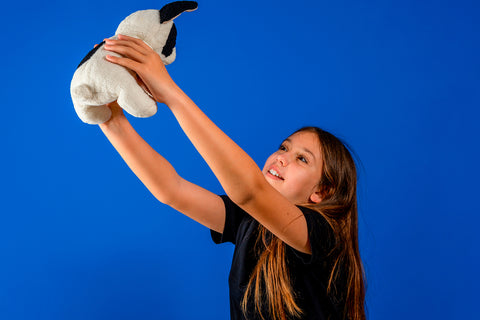
Whether they’re assigned a funny name or simply called a “stuffie,” kids love stuffed toys. A child snuggling their favorite stuffed animal, cozily tucked into bed at night, is a favorite memory for most of us. Whether kids have one special stuffed animal or a mountain of cute little critters, it’s easy to see just how important stuffed toys are to the children who own them.
While we see our children snuggle and grow attachments to their soft companions, there’s more to this relationship than meets the eye. Stuffed animals serve a greater psychological and developmental purpose than nighttime companionship. We’ve highlighted a few benefits of stuffed toys you might not have considered.
1. First Friends
A stuffed animal is often the first toy a baby receives. While at first, a stuffed toy is simply a welcome companion in baby’s room, the relationship can change over time. As they develop, children sleep and play with their stuffed animals, developing a bond more than that of owner and toy. In fact, children develop a friendship with the toy, which often becomes their very first friend.
As this relationship grows—and as children experience friendships with other children—parents often realize that a stuffed animal can provide one of the only unconditional friendships a child will have. Parents also can use these soft friends as a tool for imparting morals and good manners to their children. Thus, when children see their favorite stuffed toy, they see a friend, ally, and companion along the long road of childhood.
2. Cuddly Conversations
Conspiratorial whispers, short disagreements, bubbly giggles—these are all things children share with their favorite stuffed toys. Because of this—and after listening to parents, siblings, and other older individuals communicate—children can learn to partake in both sides of a conversation.
You’ve likely heard many children conduct a dialogue between two stuffed animals. They acquire their ability to experience and control their own emotions through these conversations and express them through verbal communication. Conversational mimicry in this capacity helps children gain the ability to practice problem-solving. It also helps them navigate tricky feelings and disputes so they can better communicate with other humans when the time comes.
3. Developing Literacy
As mentioned, when children are learning to talk, they can be seen simulating conversations with their stuffed animals. As they grow, the conversations become more complex and intricate. When this happens, children can learn and build upon their ability to tell stories.
As an extension of this learning, children develop a positive relationship with reading. While most toddlers don’t start by reading giant tomes, they may cuddle up with a stuffed animal and a picture book and read their favorite stories. Having that comfortable relationship with their toy helps children develop the confidence to practice reading and sharing stories in a friendly, low-pressure environment.
4. Increasing Imagination
There is, of course, a great deal of make-believe in the play of children. Imagined experiences and circumstances occur frequently. With their favorite stuffed animal passenger, children learn creativity and imagination during this kind of play. They also experiment with new scenarios and can think ahead to find alternative outcomes.
With this kind of play, children gain valuable problem-solving skills and may even gain tools to resolve conflict. When they learn to think up their own games or their own scenarios and magic lands, children develop the ability to think outside the box. A stuffed toy companion allows a child to participate in role-playing, imaginative play even when there are no friends or siblings to join in.
5. Self-Soothing and Compassion
While there is nothing wrong with parents soothing a child to sleep or intervening after a crisis, a parent or caregiver may not always be around. Stuffed toys are a valuable tool for managing stress and separation anxiety, and the child can use the toy to learn to navigate these feelings. When children learn coping mechanisms in early development, this important skill is something they’ll bring with them into adulthood.
Self-soothing also teaches children how to move on from negativity, which influences understanding, compassion and how to best regulate their own emotions. With the aid of a stuffed animal, many children start to trust their own emotions and feelings, as well as the nurturing and caring instincts inspired by cuddling their stuffed toys. These instincts can become deeply ingrained as children grow into teenagers and adults, becoming habits of compassionate, caring individuals.
6. Improved Mental Wellbeing
The relationship that children will have with their stuffed animals can improve their mental health. Having a toy to relieve fears and bring a sense of peace and comfort is vital for a child. When they’re recovering from a rejection by a friend or peer, they can reach for comfort from a soft, stuffed toy.
A variety of research shows the emotional benefits of snuggling a stuffed toy. The comfort of a stuffie best friend helps release fears and relieve some mild mental health afflictions. This relationship can help them build self-confidence, develop higher self-esteem, and bring better mental health into adulthood.
7. Transitional Objects
A transitional object is any object chosen by a child to supply comfort during separation from a parent, typically viewed as a child’s first external comfort object. When a parent isn’t or can’t be around, the attachment formed with a special stuffed toy serves the purpose of a transitional object.
In this way, stuffies help children transition out of an unfamiliar situation and into a place where they can experience comfort and security. Stuffies can help fill a void from a loss, however brief. While this isn’t always a permanent situation, it is one of significant help and comfort to a child.
As you can see, stuffed animals are one of the best toys you can give to a child. They promote and nurture many different developmental building blocks in a child’s life, from emotional support and mental health to reading and good behavior. When you consider all the things a child must learn in their first several years of life, it’s clear why the security and love gained through a relationship with a stuffed animal is so important during these developmental years.
